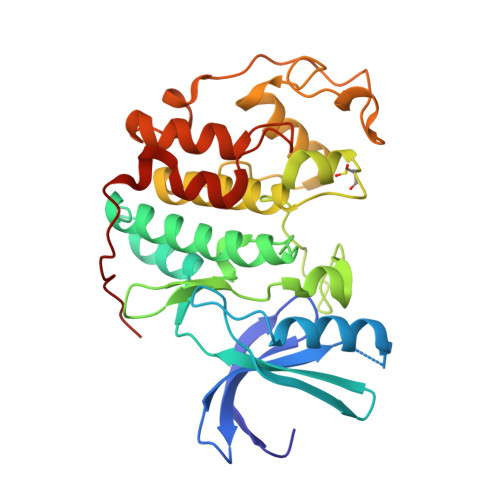8-Substituted O6-Cyclohexylmethylguanine Cdk2 Inhibitors; Using Structure-Based Inhibitor Design to Optimise an Alternative Binding Mode.
Carbain, B., Paterson, D.J., Anscombe, E., Campbell-Dexter, A., Cano, C., Echalier, A., Endicott, J., Golding, B.T., Haggerty, K., Hardcastle, I.R., Jewsbury, P.J., Newell, D.R., Noble, M., Roche, C., Wang, L., Griffin, R.J.(2014) J Med Chem 57: 56
- PubMed: 24304238
- DOI: https://doi.org/10.1021/jm401555v
- Primary Citation of Related Structures:
1W8C, 4CFM, 4CFN, 4CFU, 4CFV, 4CFW, 4CFX - PubMed Abstract:
Evaluation of the effects of purine C-8 substitution within a series of CDK1/2-selective O(6)-cyclohexylmethylguanine derivatives revealed that potency decreases initially with increasing size of the alkyl substituent. Structural analysis showed that C-8 substitution is poorly tolerated, and to avoid unacceptable steric interactions, these compounds adopt novel binding modes. Thus, 2-amino-6-cyclohexylmethoxy-8-isopropyl-9H-purine adopts a "reverse" binding mode where the purine backbone has flipped 180°. This provided a novel lead chemotype from which we have designed more potent CDK2 inhibitors using, in the first instance, quantum mechanical energy calculations. Introduction of an ortho-tolyl or ortho-chlorophenyl group at the purine C-8 position restored the potency of these "reverse" binding mode inhibitors to that of the parent 2-amino-6-cyclohexylmethoxy-9H-purine. By contrast, the corresponding 8-(2-methyl-3-sulfamoylphenyl)-purine derivative exhibited submicromolar CDK2-inhibitory activity by virtue of engineered additional interactions with Asp86 and Lys89 in the reversed binding mode, as confirmed by X-ray crystallography.
Organizational Affiliation:
Department of Biochemistry, University of Oxford , South Parks Road, Oxford OX1 3QU, U.K.
















